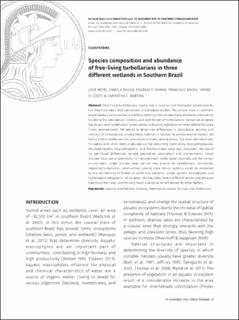| dc.contributor.author | Reyes, Jhoe | |
| dc.contributor.author | Binow, Daniela | |
| dc.contributor.author | Vianna, Rogério T | |
| dc.contributor.author | Brusa, Francisco | |
| dc.contributor.author | Colpo, Karine D. | |
| dc.contributor.author | Martins, Samantha Eslava | |
| dc.date.accessioned | 2023-03-23T11:01:56Z | |
| dc.date.available | 2023-03-23T11:01:56Z | |
| dc.date.created | 2022-12-29T14:48:10Z | |
| dc.date.issued | 2022 | |
| dc.identifier.citation | Anais da Academia Brasileiras de Ciências. 2022, 94, e20210679. | en_US |
| dc.identifier.issn | 0001-3765 | |
| dc.identifier.uri | https://hdl.handle.net/11250/3060087 | |
| dc.description.abstract | Free-living turbellarians mostly live in marine and freshwater environments, but they have been little considered in ecological studies. The coastal plain in southern Brazil harbors a diverse fauna and flora, but only a few studies have related environmental factors to the abundance, richness, and distribution of turbellarians. Hence, we analyzed the structure of turbellarian communities in floating vegetation in three differently sized limnic environments. We aimed to determine differences in abundance, density, and richness of turbellarians among these habitats in relation to environmental factors. We found 1,225 turbellarians (34 species) distributed among 6 taxa. The most abundant was Tricladida with 49.4% relative abundance; the remaining (Catenulida, Dalytyphloplanida, Macrostomorpha, Kalyptorhynchia, and Prorhynchida) were less abundant. We found no significant differences among population parameters and environments. Small shallow lakes are a potentially rich environment, while water channels are the richest environment. Larger shallow lakes are not very diverse for turbellarians. Similarities regarding turbellarian communities among close limnic systems could be explained by the connectivity of bodies of water that presents similar aquatic macrophytes and hydrological subsystems, while larger shallow lakes have a different community because they have their own contributing basin and could be influenced by other factors. | en_US |
| dc.language.iso | eng | en_US |
| dc.rights | Navngivelse 4.0 Internasjonal | * |
| dc.rights.uri | http://creativecommons.org/licenses/by/4.0/deed.no | * |
| dc.title | Species composition and abundance of free-living turbellarians in three different wetlands in Southern Brazil | en_US |
| dc.type | Peer reviewed | en_US |
| dc.type | Journal article | en_US |
| dc.description.version | publishedVersion | en_US |
| dc.source.pagenumber | 18 | en_US |
| dc.source.volume | 94 | en_US |
| dc.source.journal | Anais da Academia Brasileiras de Ciências | en_US |
| dc.identifier.doi | 10.1590/0001-3765202220210679 | |
| dc.identifier.cristin | 2098015 | |
| dc.source.articlenumber | e20210679 | en_US |
| cristin.ispublished | true | |
| cristin.fulltext | original | |
| cristin.qualitycode | 1 | |

